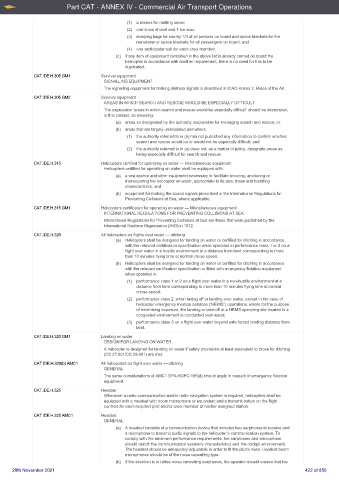Page 422 - UK Air Operations Regulations 201121
P. 422
Part CAT - ANNEX IV - Commercial Air Transport Operations
(1) a means for melting snow;
(2) one snow shovel and 1 ice saw;
(3) sleeping bags for use by 1/3 of all persons on board and space blankets for the
remainder or space blankets for all passengers on board; and
(4) one arctic/polar suit for each crew member.
(c) If any item of equipment contained in the above list is already carried on board the
helicopter in accordance with another requirement, there is no need for this to be
duplicated.
CAT.IDE.H.305 GM1 Survival equipment
SIGNALLING EQUIPMENT
The signalling equipment for making distress signals is described in ICAO Annex 2, Rules of the Air.
CAT.IDE.H.305 GM2 Survival equipment
AREAS IN WHICH SEARCH AND RESCUE WOULD BE ESPECIALLY DIFFICULT
The expression ‘areas in which search and rescue would be especially difficult’ should be interpreted,
in this context, as meaning:
(a) areas so designated by the authority responsible for managing search and rescue; or
(b) areas that are largely uninhabited and where:
(1) the authority referred to in (a) has not published any information to confirm whether
search and rescue would be or would not be especially difficult; and
(2) the authority referred to in (a) does not, as a matter of policy, designate areas as
being especially difficult for search and rescue.
CAT.IDE.H.315 Helicopters certified for operating on water — miscellaneous equipment
Helicopters certified for operating on water shall be equipped with:
(a) a sea anchor and other equipment necessary to facilitate mooring, anchoring or
manoeuvring the helicopter on water, appropriate to its size, mass and handling
characteristics; and
(b) equipment for making the sound signals prescribed in the International Regulations for
Preventing Collisions at Sea, where applicable.
CAT.IDE.H.315 GM1 Helicopters certificated for operating on water — Miscellaneous equipment
INTERNATIONAL REGULATIONS FOR PREVENTING COLLISIONS AT SEA
International Regulations for Preventing Collisions at Sea are those that were published by the
International Maritime Organisation (IMO) in 1972.
CAT.IDE.H.320 All helicopters on flights over water — ditching
(a) Helicopters shall be designed for landing on water or certified for ditching in accordance
with the relevant certification specification when operated in performance class 1 or 2 on a
flight over water in a hostile environment at a distance from land corresponding to more
than 10 minutes flying time at normal cruise speed.
(b) Helicopters shall be designed for landing on water or certified for ditching in accordance
with the relevant certification specification or fitted with emergency flotation equipment
when operated in:
(1) performance class 1 or 2 on a flight over water in a non-hostile environment at a
distance from land corresponding to more than 10 minutes flying time at normal
cruise speed;
(2) performance class 2, when taking off or landing over water, except in the case of
helicopter emergency medical services (“HEMS”) operations, where for the purpose
of minimising exposure, the landing or take-off at a HEMS operating site located in a
congested environment is conducted over water;
(3) performance class 3 on a flight over water beyond safe forced landing distance from
land.
CAT.IDE.H.320 GM1 Landing on water
DESIGN FOR LANDING ON WATER
A helicopter is designed for landing on water if safety provisions at least equivalent to those for ditching
(CS 27.801/CS 29.801) are met.
CAT.IDE.H.320(b) AMC1 All helicopters on flight over water — ditching
GENERAL
The same considerations of AMC1 SPA.HOFO.165(d) should apply in respect of emergency flotation
equipment.
CAT.IDE.H.325 Headset
Whenever a radio communication and/or radio navigation system is required, helicopters shall be
equipped with a headset with boom microphone or equivalent and a transmit button on the flight
controls for each required pilot and/or crew member at his/her assigned station.
CAT.IDE.H.325 AMC1 Headset
GENERAL
(a) A headset consists of a communication device that includes two earphones to receive and
a microphone to transmit audio signals to the helicopter’s communication system. To
comply with the minimum performance requirements, the earphones and microphone
should match the communication system’s characteristics and the cockpit environment.
The headset should be adequately adjustable in order to fit the pilot’s head. Headset boom
microphones should be of the noise cancelling type.
(b) If the intention is to utilise noise cancelling earphones, the operator should ensure that the
20th November 2021 422 of 856

